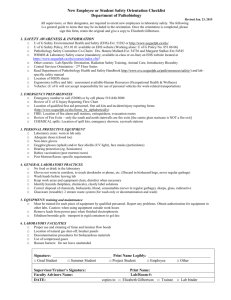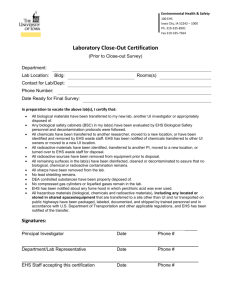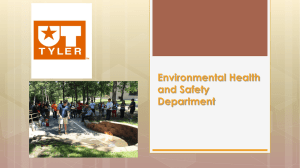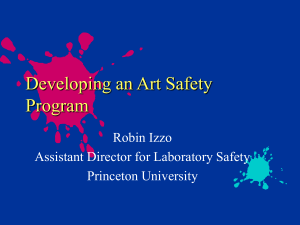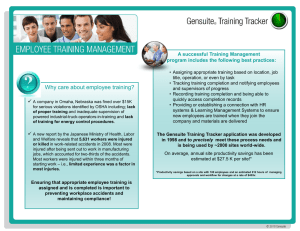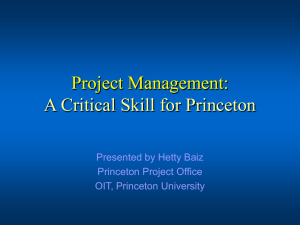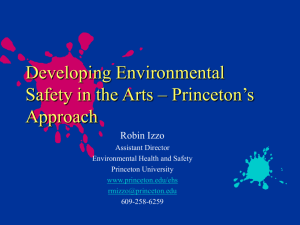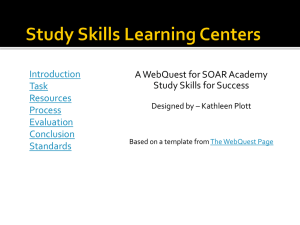The Double Challenge: Laboratory Safety in Academia
advertisement
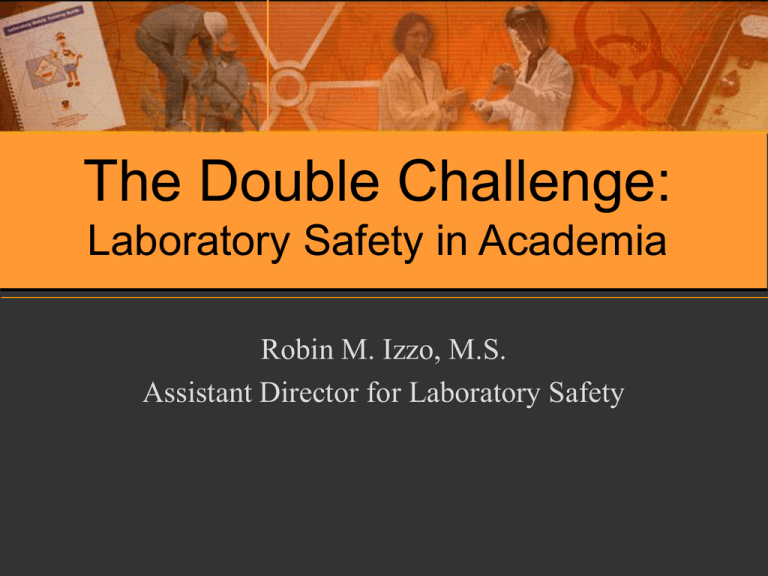
The Double Challenge: Laboratory Safety in Academia Robin M. Izzo, M.S. Assistant Director for Laboratory Safety An Unfortunate Truth • Researchers need to know a lot about a few things. They go around learning more and more about less and less until they know everything about nothing • Administrators need to know a little about a lot of things. They go around learning less and less about more and more until they know nothing about anything. • Safety professionals start out knowing everything about everything and end up knowing nothing about anything because they have to deal with researchers and administrators. The Academic Challenge • Inexperienced lab workers • High turnover • Academic Freedom • Decentralization • The “Institutes” • Variable Funding • Research Focus • Foreign Students Inexperienced Lab Workers • Graduate Students – Direct from Undergrad – Industry experience • Undergraduates • Faculty – Academia vs. Industry High School Students • • • • • Summer study Part-time study Science Fair projects NJ Child Labor Law Paid vs. Unpaid High Turnover • Graduate Students – 2-6 years • Undergrads – 1-2 years • Checkout Problems – Chemicals left behind – Unusual labeling – Old equipment Training • EHS Training – General Lab Safety – Specialty » Rad, Laser, LOTO, BBP, Live Virus, Animal, Respirator, MRI, Noise, Hoisting/Rigging • • • • Graduate Students Undergrads Post-docs PI Responsibility Academic Freedom • Academic Freedom ≠ Freedom from Responsibility • Who is responsible for safety? • Freedom vs. Security – US PATRIOT Act Lab Supervisor Training • “Briefing” rather than “Training” • Personal meeting with me • Responsibilities for safety, environment and security • University Expectations • Available resources – Health and safety-related – Other, e.g., power, security, registration • Lab Profiling Profiling Tool • Series of questions relating to lab operations • Determines which health and safety programs apply • Training Matrix Are machines or mechanical systems (e.g. materials handling equipment, internal combustion engines, pressurized systems) or powered tools used? Program Codes: 7, 9 Do individuals work on or near exposed electrical circuits? Program Code: 6, 7 Do individuals work from elevated surfaces (greater than four feet above the surrounding surfaces), ladders or conduct work on the roof of a building? Program Codes: 10, 11 Does your facility contain spaces that must be entered by personnel that are not intended for normal occupancy and that have limited means of entry (e.g. tanks, vessels, pits, etc.) Program Codes: 12, 7, 10 Do individuals perform cutting, welding, brazing, torch soldering, etc.? Program Codes: 13 Do individuals perform work that involves rigging or hoisting operations? Program Code: 14 Can you reasonably anticipate that individuals might have exposure to human blood or other body fluids? Program Code: 22 Decentralization • No central purchasing • No central receiving • No central waste storage/pickup area • 12 Science and Engineering Departments How to Deal? • • • • • • • Department Safety Managers Chemical Hygiene Officers Safety Manager Breakfasts Safety Committees Lab Managers Listserves Waste Paper The “Institutes” • New research trend – Mix researchers from several different disciplines » » » » Computer science Biological sciences Engineering Chemistry – One main focus » Integrative Genomics » Material Science » Nanotechnology – One building for many types of research Institute Challenges • Whose department is it anyway? – Each researcher is from one major department, but part of the Institute – Host department and institute do not always communicate • Building Design – Must be changeable – Open design most common Open Lab Design • Open to promote “bumping into each other” • Common spaces, food courts, etc. They don’t know how to share! Lewis Sigler Institute for Integrative Genomics Lewis-Sigler Institute for Integrative Genomics Lewis-Sigler Institute for Integrative Genomics Open Lab Design • Difficult to separate special functions – – – – – Live viruses Radioactive materials work Particularly hazardous substances Clean rooms Select agents Open Lab Design • The “Lego” effect – Today it’s a computer lab, tomorrow a laser lab – Moveable walls • Overhead utilities • Interstitial spaces Variable Funding • • • • Some PIs are better funded than others May vary from year to year Still the same safety issues No central funding for safety (except hazardous waste) Research Focus • New faculty may mean completely new EHS challenges – Dive officer – Overseas research » EHS in another country – Need to become instant expert in some new area of EHS Pregnancy and The Lab • • • • • No formal policy Official Declaration of Pregnancy Confidentiality Lab Screening Outcomes depend on the woman – – – – Lab work as usual Restrict certain activities Non-lab work Leave of absence Foreign Researchers • English as a second language – Training – Written materials • Cultural differences – Safety – Environmental – Personal • US PATRIOT – Background checks Turning Lemons in to Lemonade Using Accidents and Incidents to Your Advantage Incidents and Accidents • • • • Not very common Most are minor The “bad” ones can always be a lesson Incident reporting and investigation – Root cause – No blame – Examples Incidents and Accidents • Use in training – Makes it seem more important – Use examples that happened right here at Princeton University – Do not use examples from completely unrelated disciplines – Anecdotes Section of Princeton University Lab Safety Manual – most popular site Chloroform Incident • • • • Chloroform under pressure Misuse of fume hood sash Wrong eye protection Incorrect use of safety shower Laser Incident - Electrical • • • • • Opened housing Bypassed interlock Condensation problem First aid/CPR Defibrillation Laser Incident - Eye • Assumed low risk • Jerry-rigged equipment • Permanent damage to eye • Clear and critical vision (Fovea) Hey, This is Not Coffee! • Buffer solution • Coffee cup on lab bench • Chose the wrong cup • Lucky is wasn’t hazardous Dartmouth Professor • Tiny amount dimethylmercury • Wrong glove • Death from mercury poisoning • Choose the right glove Bursting Flask • • • • • Sat in LN2 No vacuum Looked for crack Burst Cryogenic liquid hazard Flying Flaming Hexane • Heat in beaker with heat gun • Vapors contacted motor • Threw across room • Computer ruined HF Incident • Grabbed outside of container • Ungloved hand • 3 hour delay • Severe burn Nitric Acid Waste Incident • • • • Methanol container Nitric Acid waste Burst Miracle LAH Fire • Water reactive • Lab coat • Fire extinguisher failure Beyond Compliance Fostering a culture that promotes environmental stewardship Step One - Compliance • EPA Multimedia Audit – Target colleges and universities – Very large fines – RCRA and labs are not a good fit • Education – Training and meetings – Policy on Fines • Inspections Pollution Prevention Source Reduction Recycle/Reclaim Treatment Dispose Promoting P2 • • • • • • • Check purchasing records Watch waste Pollution Prevention web site Lab or operation assessments Share successes A little competition Stress/share the financial benefits Successes • Waste reduction by more than 60% • Microscale • No chromium-based cleaners • Mercury thermometer swaps • Water-free pumps • Chilled water loops Questions? Contact Information • Robin Izzo Assistant Director for Laboratory Safety Environmental Health and Safety Princeton University 262 Alexander Street Princeton, NJ 08544 • 609-258-6259 (phone) • 609-258-1804 (fax) • rmizzo@princeton.edu • http://www.princeton.edu/ehs • http://web.princeton.edu/sites/ehs/labsafetymanual/index.html (Lab Safety Manual)



